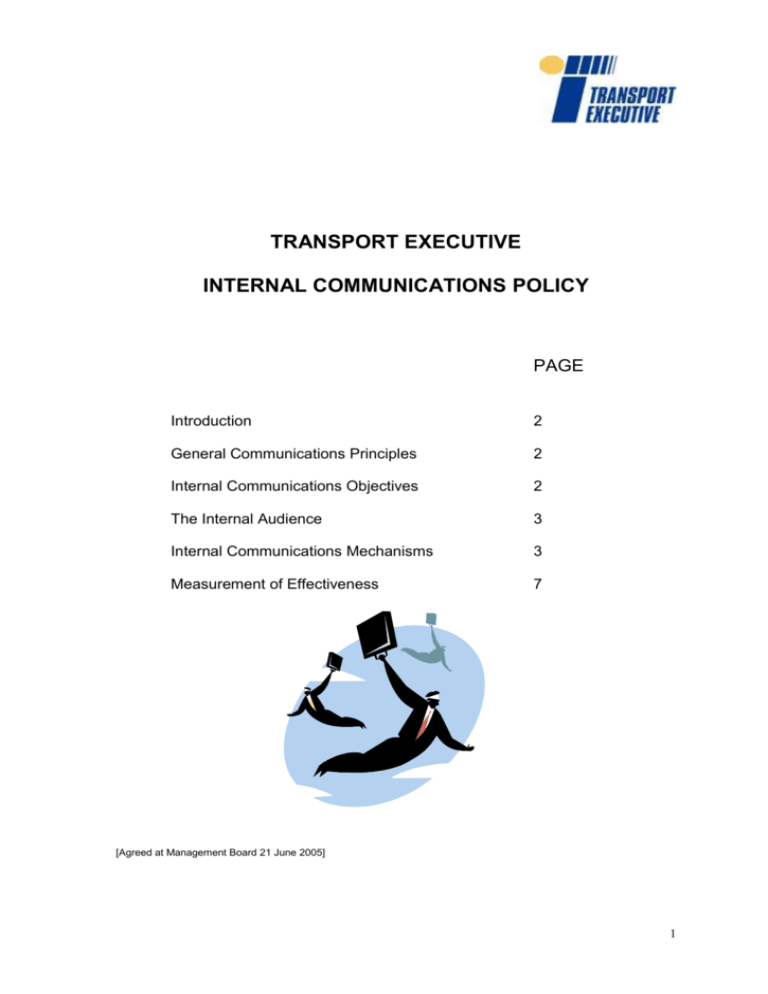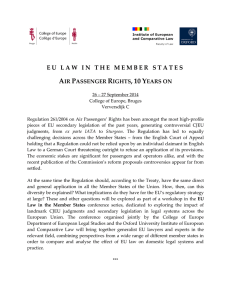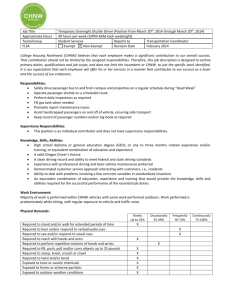Internal Communications Policy - South Yorkshire Passenger
advertisement

TRANSPORT EXECUTIVE INTERNAL COMMUNICATIONS POLICY PAGE Introduction 2 General Communications Principles 2 Internal Communications Objectives 2 The Internal Audience 3 Internal Communications Mechanisms 3 Measurement of Effectiveness 7 [Agreed at Management Board 21 June 2005] 1 1. Introduction The Transport Executive recognised the need to further improve its internal communication for the benefit of employees following the results obtained from the Employee Attitude Survey 2004. Significant time and resources have been allocated to this area of work as it is recognised that the most important relationship an organisation has are those with its employees. As such the Internal Communications Policy has been developed by the Transport Executive to ensure that employees and Line Managers are aware of, and understand the Transport Executive’s approach to Internal Communications. Aligned to the existing Internal Communications Protocol and our organisational values this Policy, details communication principles, objectives and mechanisms developed to enhance Internal Communications within our organisation. 2. General Communications Principles The Transport Executive has a responsibility to be open and honest about what it does and part of that is communicating with its employees. The organisational values of integrity and respect states:“that the Transport Executive should foster an environment where openness, trust and respect are the norm.” Therefore, the principles that underpin the Internal Communications Policy are: Open and honest – straightforward and transparent. Timely – information when and to whom it is needed. Accessible – clear, inclusive and throughout the organisation. Appropriate – the right information delivered in the right way in the appropriate language for the target audience. Two-way – allowing for full involvement with feedback channels. 3. Internal Communications Objectives The key objectives of the Internal Communications Policy are: To communicate clear consistent messages to all employees regarding the business and issues that affect the Transport Executive. To inform employees about the Transport Executive’s activities first, before being informed by external audiences. To identify the mechanisms to be utilised when communicating with the internal audience. 2 4. The Internal Audience The Transport Executive employs approximately 350 direct employees. A significant number of these employees are based within the Head Office in Sheffield, with the remainder located at the Transport Interchanges, and Travel Information Centres throughout South Yorkshire. Contractors carry out the majority of “front-line” jobs at Interchanges, such as cleaning, security and customer service roles and as such are included within parts of this Policy. 5. Internal Communications Mechanisms The Transport Executive uses a number of mechanisms to formally communicate with employees. These are:- Management Board Team Brief - a monthly cascade of information from the Management Board meetings through Line Managers to all employees. Each month, the Management Board Team Brief contains a number of articles relating to key business issues. These are determined by the Management Board. In addition, to this content, a monthly communications ‘theme’ will be included, with a corresponding article about that ‘theme’. The programme of communications themes for 2005/06 is attached as Appendix A. Additionally, the monthly Management Board Team Brief facilitates twoway communication by the inclusion of a mechanism for feed-back, e.g. employees can ask questions (on behalf of their Team, not necessarily as individuals) that during a Team Briefing should their Line Manager be unable to answer directly, it is then recorded. Questions are then sent by the Line Manager to the Communications Department, who will then coordinate an appropriate response on behalf of the Management Board Attendees. The questions and corresponding answers will then be collated and attached to the following Management Board Team Brief and will be made available to all employees. Therefore, issues raised from different Departments, and the appropriate management response/position will be 3 disseminated to all employees within one month. A completed example is attached as Appendix B. Key purpose:- To communicate key business issues from the Management Board Meetings and facilitate two-way communication. Directors’ Briefings - A programme of business updates and an opportunity for Line Managers to meet Directors and discuss business issues. Attendees are encouraged to ask questions and are required to cascade the information obtained from these sessions to their respective Teams. Key purpose:- To allow for face-to-face meetings between Directors and Line Managers. To update messages on business objectives, priorities and targets. Accessible Management - A Policy of Accessible Management has been further developed since March 2005. The Management Board Learning Centre Drop-In Sessions facilitate direct contact with the Management Board. Additionally, Management Board are regularly visiting employees on “walkabouts”. Key purpose:- Direct cross-functional access to Management Board Attendees in order to increase approachability, and both disseminate and receive business related information. Line Manager Team Briefings - Used by Line Managers to disseminate information about their respective Departments and the organisation Key purpose: - To disseminate direct information between Line Manager and their Team in relation to departmental and organisational information. 4 Valued Interviews - Performance Review and Objective Setting interview undertaken between the Line Manager and employee. This process includes an employee development element, which identifies Learning and Development needs. Key purpose:- Performance Review and Direction Setting. One-to-one Employee Briefings - Direct Interface between Line Manager and employee to discuss a broad spectrum of issues including both business related and personal issues. Key purpose:- To disseminate direct information and enhance the employee relationship. E-mail/Frast-track News Bulletin - Formal news bulletins to all employees. To be used for quick dissemination of business/industry related news that all employees should be aware of. Only the Communications Department and the Directors have the authority to issue these bulletins, which has a specific corporate design and template attached as Appendix C. This sets them apart from other “All-Staff E-mails” that are sent out. Line Managers are required to ensure that all their employees have read the Fast-track News Bulletins within two working days of issue where ever possible. Examples where a Fast-track News Bulletin should be used are:- 5 Key personnel announcements (such as changes to Management Board, Passenger Transport Authority). Major funding awards. News regarding major incidents at Interchanges. . Key purpose:- Quick and easily identified direct updates to all employees on business related issues. E-mail - Produced as required, depending on the flow of information. Key purpose:- To provide time critical information to named individuals or groups of employees. Used by the Communication Department to circulate all press releases to employees to ensure they receive news updates before it appears in the media. Intranet - Carries a broad range of information available to all employees with PC access. Departments are responsible for updating their own areas of the Intranet site. Key purpose:- To provide instantly updated news and information for employees. It relies upon the user to “pull’ the information, rather than a communications “push”. Executive Exchange - Internally produced employee newspaper circulated on a monthly basis. It is delivered to all employees, regardless of location. The Communications and Human Resources Department will agree the contents of the newspaper. A monthly column is included by the Directors. Key purpose:- To keep employees up-to-date on the latest developments within their Department and the organisation. Effective method of keeping each other informed about issues/activities. 6 Notice Boards - A number of notice boards are located on each floor at Head Office, Sheffield and throughout the Transport Executive sites within South Yorkshire. Key purpose:- To provide communications material to be read at the employee’s convenience. Used for non-urgent news and information. Telephone - Direct contact with an identifiable person. Key purpose:- Quick and direct method of communication. 7. Measurement of Effectiveness To determine which communications methods are the most effective and popular with employees, an Employee Attitude Survey will be carried out on annual basis. 7 APPENDIX A MANAGEMENT BOARD TEAM BRIEFING PROGRAMME OF COMMUNICATION THEMES 2005/06 8 APPENDIX A DRAFT SYPTE Internal Communications Plan October 2005 – September 2006 Month Theme Champion Team Brief Draft Issue 1 October 2005 Budgets PL 2 November Capital Programme DY Draft Issue 3 December Valued DM Draft Issue 4 January 2006 Health and Safety DY Draft Issue 5 February LTP Progress GR Draft Issue 6 March Customer Service MMc Draft Issue 7 April Business Plan RW/DB Draft Issue 8 May Learning and Development DM Draft Issue 9 June Current Issue RW Draft Issue 10 July Current Issue DB Draft Issue 11 August Network Developments DY Draft Issue 12 September Health and Safety DY Draft Issue Authorised for issue by:_________________________________________________ Team Brief returns Executive Exchange Draft Proof Issue 15 Draft Proof Issue 15 Draft Proof Issue 15 Draft Proof Issue 15 Draft Proof Issue 15 Draft Proof Issue 15 Draft Proof Issue 15 Draft Proof Issue 15 Draft Proof Issue 15 Draft Proof Issue 15 Draft Proof Issue 15 Draft Proof Issue 15 Directors’ Team Briefings (theme) Communications Events ‘Training and Development Week’ ‘Health and Safety Week’ Date:__________________________ Distribution: Management Board Attendees / HR & Communications Department 9 APPENDIX B MANAGEMENT BOARD TEAM BRIEFING QUESTIONS AND ANSWERS 10 REF 0/05 TEAM BRIEFING ITEMS PROCESS Management Board Members to disseminate within five working days of the Management Board Meeting to their Management Team. Following which, Line Managers are to disseminate information to their respective teams within five working days. * NB No more than four hierarchical levels of briefing will take place and as such the cascade process will be complete within a maximum of twenty working days. Team briefing Items arising from the Management Board Meeting For more information please contact the author of the item indicated below:- QUESTIONS AND ANSWERS These questions would be raised at the Management Board, and assigned to a member of the Management Board for a reply. This answer would then be passed to the Communications Department and be printed in the following month’s Team Brief. Q: What’s the latest position on the Passenger Transport Executive moving from the Exchange Street offices? Are we staying in Sheffield? (Question from: Finance Department) A: We have been looking at a number of potential sites for relocation of the Exchange Street offices. There are number of options nearby and employees will be kept fully informed and consulted about any progress on this issue. (Paul Lambert, Chief Financial and Services Officer) Q: Why can’t the Passenger Transport Executive take major decisions by always having to pass it onto the Passenger Transport Authority to decide. The Passenger Transport Executive are surely the transport experts, not just elected councillors with non-transport backgrounds? (Question from Traveline) A: The Passenger Transport Executive works for all four District Councils within the South Yorkshire area and is indeed funded through the Council Levy. The Passenger Transport Authority comprises of elected members from each of the Four District Councils and we meet monthly to advise them on progress in meeting the Passenger Transport Authorities’ objectives. 11 The Passenger Transport Authority members represent the people that ultimately fund the Passenger Transport Executive – Council Tax Payers – and as we are publicly, accountable, all major decisions are taken with the backing of the Passenger Transport Authority. These Passenger Transport Authority meetings are also open to the public and press, so we are, therefore, open about what we do and how we spend public money. (Roy Wicks, Director General). Q: How popular have the Learning Centre Drop-in sessions been? What about those who don’t work on Fridays or work at other locations? (Question from: OIS) A: The sessions have been fairly well attended up to now, but we would like to see more people take up the opportunity to discuss issues with the Management Board Attendee. If you are unable to make it on a Friday or get to Exchange Street, please contact any member of the Learning and Development or Human Resources Teams. Or, why not contact the member of the Management Board Attendee direct? (Dawn Madin, Head of Human Resources and Communications). Q: Does the Passenger Transport Executive ever stand up to or challenge the Government especially when it can’t make decisions on big important transport schemes, or does it just put up with things? (Question from: Human Resources) A: We have regular dialogue with the Department of Transport, who are well aware of our aspirations and plans to develop public transport in the County. Together with our colleagues in other Passenger Transport Executives, we actively target the Government over major issues – a collective voice is often more effective than an individual one. However, we have to be realistic when it comes to demanding money for major projects. We have to present what we think are the best transport solutions for the County, whilst remembering we aren’t the only ones looking for cash. Not only are there six other Passenger Transport Executives, but dozens of District Councils all after the same funding. (Roy Wicks, Director General). Q: Why don’t we have a canteen or at least an area where we can take a break at Exchange Street – surely, there is room in Castle Gate? A: The building at Exchange Street isn’t ideal and that is one reason why we have been considering relocating to a building better suited to our needs. There simply isn’t the room in the 12 building for such a facility, but if we do move, all aspects of employee accommodation will be considered. Q: Why does the Passenger Transport Executive have to set up a Driver Training Academy – isn’t this just yet another case of the operators shirking their responsibilities in the name of profit? (Question from: Communications) A: The Transport Academy is available to all transport employees across the county, and many of our own employees and contractors have signed up for courses. Please contact either the Human Resources or Learning and Development Teams for more information. (Dawn Madin, Head of Human Resources and Communications). 13 APPENDIX C FAST-TRACK BULLETIN 14 Fast-track Bulletin Dear Colleague As I'm sure you are all aware the bus forms the core of the public transport network across South Yorkshire and therefore is at the heart of what we do in the Transport Executive. You may also be aware that bus patronage has been in decline over recent years. We need to identify and deliver a plan to halt and reverse this decline. In recent months, a small team has been busy working with our partners at the 4 Districts on the South Yorkshire Bus Strategy for 2006 - 2011 which is a fundamental part of our second Local Transport Plan (LTP). This strategy maps out what the real issues are and outlines the different options available to us and our partners in the bus industry. The Bus Strategy will be a key part of what we do over the next 5 years. I'm keen that you all get the opportunity to be part of what is a vitally important issue for not only us as an organisation, but the county as a whole. The Strategy is currently with our external stakeholders for consultation, and we have already received some interesting feedback. I'd like to offer you all the opportunity to see what the strategy is all about and what it could mean to us in future. In the latest issue of Executive Exchange, an article explains many of the key points in the strategy, and the full document is also available on the intranet at: http://syptenet/Resources/Strategic%20Planning/BusStrategy/StrategyDraftconsultation-090305.doc http://syptenet/Resources/Strategic%20Planning/BusStrategy/StrategyDraftconsultation-090305.doc Please take time to read at least one of these articles. Over the next month you will have to opportunity to find out more about the strategy and also let us know what you think. There will be a number of briefing / drop-in sessions where you can come along to find out more. We are at an important stage in determining the future for local bus travel. If you'd like to find out more about the key points in the Bus Strategy, please do not hesitate to contact myself, Cathy Masserella, David Young or Graham Read. If you have any suggested improvements please forward these to Mike Holmes. Regards, David Brown 15





